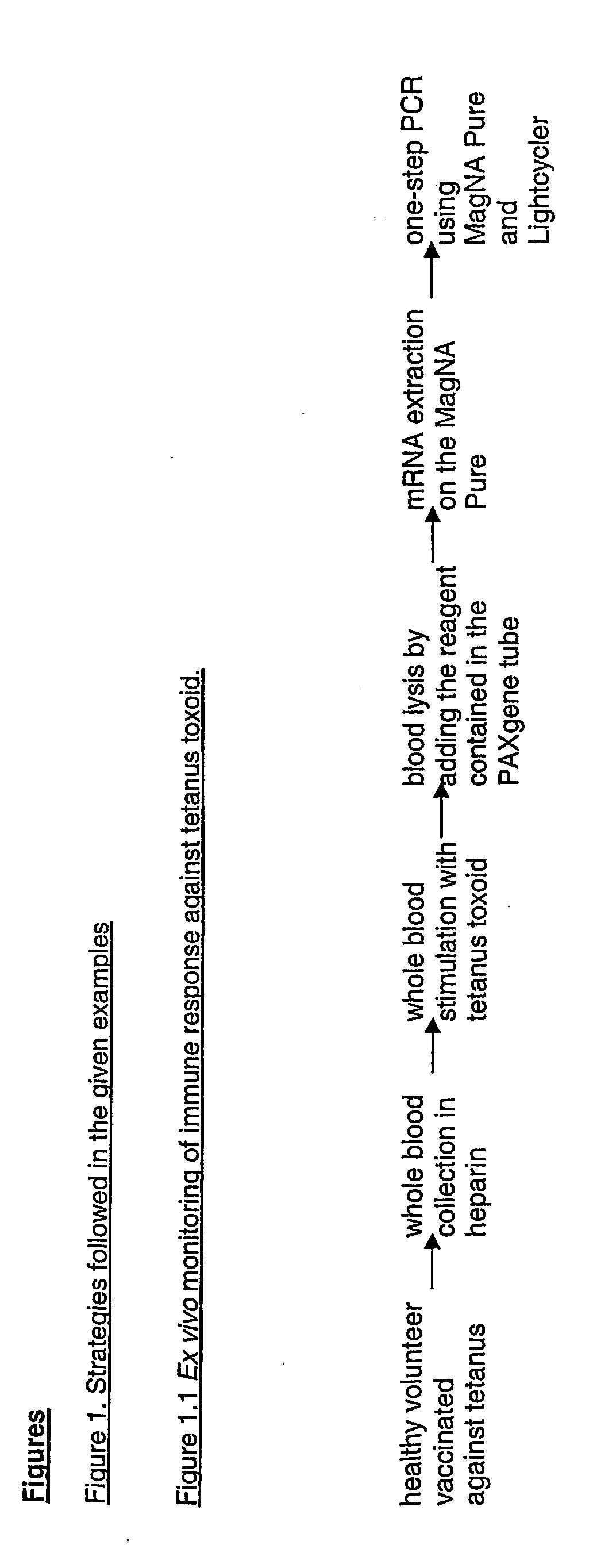Method to determine in vivo nucleic acid levels
a nucleic acid level and in vivo technology, applied in the field of new nucleic acid analysis methods, can solve the problems of inability to determine real in vivo levels of rna, inability to accurately determine mrna levels, and inability to detect rna in vitro
- Summary
- Abstract
- Description
- Claims
- Application Information
AI Technical Summary
Benefits of technology
Problems solved by technology
Method used
Image
Examples
example 1
Analysis of Spontaneous Cytokine mRNA Production in Peripheral Blood
[0183] The quantification of the cytokine mRNAs synthesized by peripheral blood cells should make it possible to estimate a “peripheral immune statute”. However, an accurate quantification can only be performed from a fresh whole blood sample in which mRNA is protected against nuclease digestion, and where gene transcription is inhibited. As discussed in this note, this has been made possible by the use of surfactant reagents such as tetradecyltrimethylammonium oxalate. RT-PCR for the quantification of IL-10 and IFN-γ mRNAs spontaneously produced in peripheral blood was performed. The results showed pronounced higher IFN-γ transcript levels in whole blood compared to peripheral blood mononuclear cells (PBMC) from the same individuals, while no significant difference was observed for IL-10 mRNA. The higher amounts of IFN-γ mRNA observed in blood can be attributed at least to mRNA degradation. Using a real time PCR t...
example 2
Comparison Between the PAXgener™ Blood RNA System and Proposed Method According to the Present Invention
[0186] With the ‘PAXgene™ Blood RNA System’ is meant the combination of the PAXgene™ Blood RNA Tube’ with the ‘PAXgene™ Blood RNA Kit’. With the ‘Qiagen Method’, it is meant ‘PAXgen™ Blood RNA Kit’.
[0187] Based on the experimental evidence described in Stordeur et al, J Immunol Methods, 259 (1-2): 55-64, 2002, the present invention proposes a new procedure to isolate mRNA from whole blood which allows to determine in vivo transcript levels using an easy and reproducible method. The PAXgene™ blood RNA System and the method according to present invention are schematically compared in FIG. 3.
Material and Methods:
[0188] All experiments were performed from peripheral venous blood directly collected in PAXgene™ Blood RNA Tubes as recommended by the PAXgene™ Blood RNA System (Qiagen) (i.e. 2.5 ml of blood were vacuum collected within the tube that contains 6.9 ml of an unknown reage...
example 3
Ex vivo Monitoring of Immune Response Against Tetanus Toxoid
[0196] In example 3, blood is stimulated ex vivo with an antigen (i.e. tetanus toxoid) against which the blood donor is supposed to be immunised (because vaccinated seven years ago). RT-PCR is performed according to the method (FIG. 1.1). Cytokine mRNA is measured as a read out of the ability of the volunteer's immune system to react against the antigen. The IL-2, IL-4, IL-13 and IFN-γ mRNAs are preferentially analysed, but all potentially reactive proteins can be analysed via the quantification of their corresponding mRNA. Results of example 3 is shown in FIG. 4. Generally the strategy followed in this example can be schematically represented as shown in FIG. 1.2.
Example of Possible Application: Cancer Immunotherapy
[0197] Since some years, basic strategies on cancer immunotherapy evolved in the way of the vaccination. In fact, the progresses in genetic and in immunology have allowed identifying a number growing tumor a...
PUM
| Property | Measurement | Unit |
|---|---|---|
| volume | aaaaa | aaaaa |
| volume | aaaaa | aaaaa |
| volumes | aaaaa | aaaaa |
Abstract
Description
Claims
Application Information
 Login to View More
Login to View More - R&D
- Intellectual Property
- Life Sciences
- Materials
- Tech Scout
- Unparalleled Data Quality
- Higher Quality Content
- 60% Fewer Hallucinations
Browse by: Latest US Patents, China's latest patents, Technical Efficacy Thesaurus, Application Domain, Technology Topic, Popular Technical Reports.
© 2025 PatSnap. All rights reserved.Legal|Privacy policy|Modern Slavery Act Transparency Statement|Sitemap|About US| Contact US: help@patsnap.com



